
Which State Has More Venomous Snakes: Arizona or Louisiana?
On opposite sides of the United States’s southern border, Arizona and Louisiana are two diverse states when it comes to nature. Whether it is the notable San Francisco peaks and deserts in Arizona or the Mississippi River and coastal marshes in Louisiana, each has a unique set of outdoor areas. Along with their differentiating outdoors, both states are also home to their own set of wildlife, including snakes. It is important to learn about these slithering reptiles so that locals and tourists can avoid being bitten. That said, which state houses more of these snakes? This article dives into the venomous species of Arizona and Louisiana, from the timber rattlesnake to the coral snake, to find out which state has more.
Venomous Snakes In Arizona
With its varying landscapes, from deserts and mountains to forests and rivers, Arizona is home to a rich ecosystem when it comes to snakes. The state boasts around 40 species ranging from the non-venomous Arizona milk snake to the venomous sidewinder rattlesnake. Many of these species are only found in and around the southwestern United States, so visitors need to keep an eye out when exploring. In terms of venomous snakes, Arizona has over a dozen species, including rattlesnakes, kingsnakes, and coral snakes.
Arizona Coral Snake (Micruroides euryxanthus)
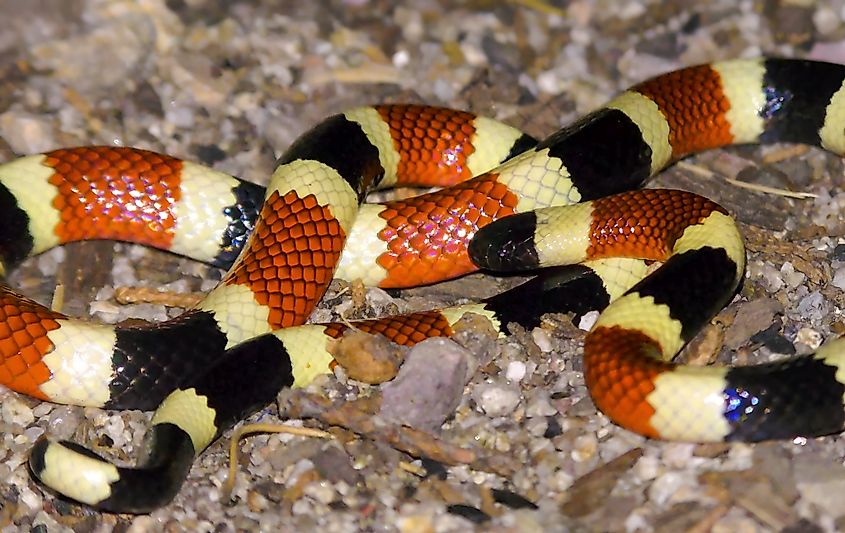
The Arizona coral snake, also known as the Sonoran coral snake, is a venomous snake species endemic to parts of Mexico and the southwestern United States. The species features the tell-tale coloration of coral snakes, with red and black rings separated by smaller yellow rings throughout its body. Most Arizona coral snakes reach a length of up to 24 inches, making them one of the smaller species on this list. They are known for having a potent neurotoxic venom, which can cause pain and decay, but there has never been a death attributed to the Arizona species. These snakes are also known to hide their head when threatened, making them less likely to bite.
Mojave Rattlesnake (Crotalus scutulatus)
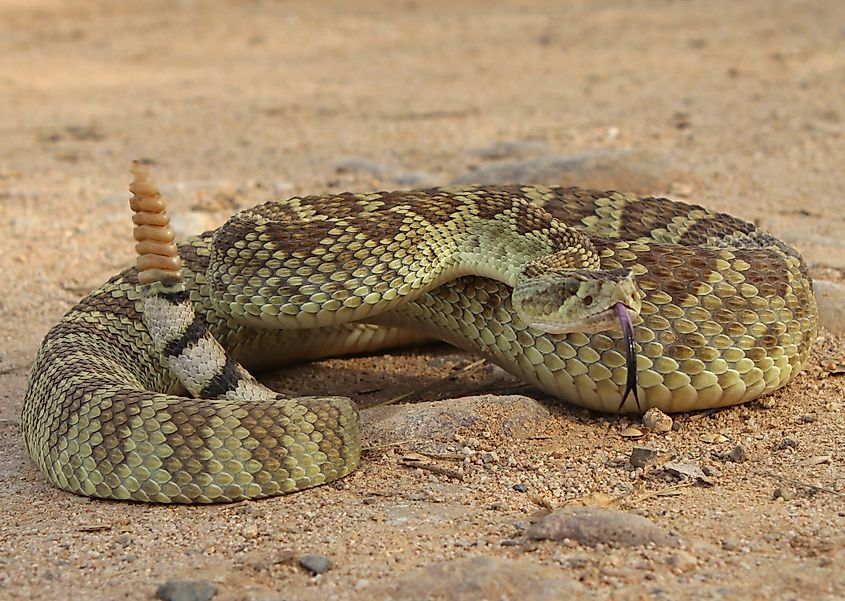
One of America’s famed rattlesnake species, the Mojave rattlesnake is a venomous pitviper found in the deserts of Arizona. It is identifiable in the wild by various unique color patterns, such as its large crown scales, yellow-black rattler, and dark brown diamond-shaped blotches. These snakes can also grow quite large, reaching a maximum length of 4.1 feet for males and 3 feet for females. Their venom contains a potent neurotoxin, which can lead to pain, paralysis, and problems breathing. Due to frequent bites, fatalities do take place, so if you ever hear a rattle in the desert, it’s advisable to walk away from it.
Western Diamondback Rattlesnake (Crotalus atrox)
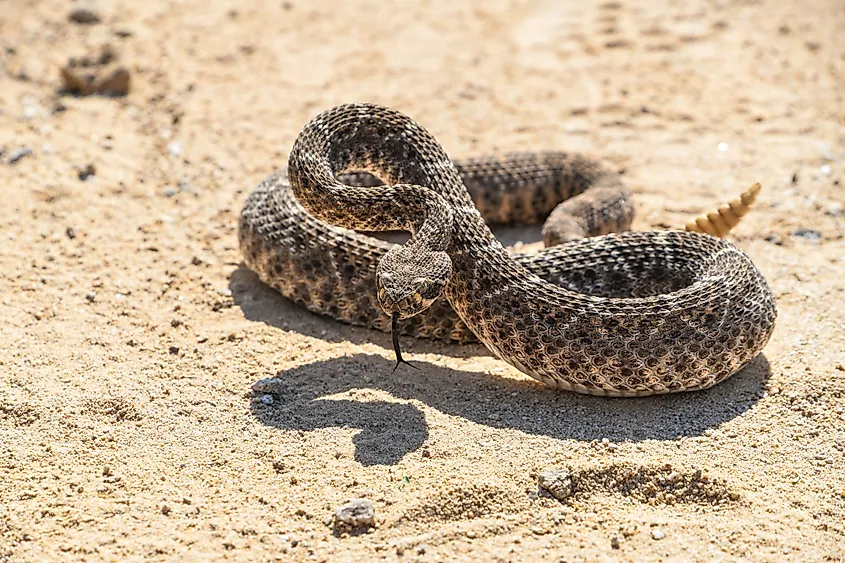
Another member of the Crotalus genus, the western diamondback rattlesnake, is one of the most common venomous species in the Southwestern United States. It features a strong venom that is hemotoxic, cytotoxic, and myotoxic. Thus, a bite can cause various issues, from internal bleeding and swelling to necrosis and convulsions. Current estimates suggest fatalities from untreated bites are around 10%, but the likelihood of death with prompt treatment is very low.
Western diamondback rattlesnakes are primarily found in areas up to 6,500 feet above sea level in northern Mexico and the Southwestern United States, including Arizona. The snake has a khaki to red coloration with hexagonal to diamond-shaped blotches that are darker in color. On its tail, western diamondback rattlesnakes have two to eight rings, primarily in a yellowish tint. Adults grow to an average of 4 feet long, although larger specimens have been noted over 5 feet.
Tropical Vine Snake (Oxybelis aeneus)
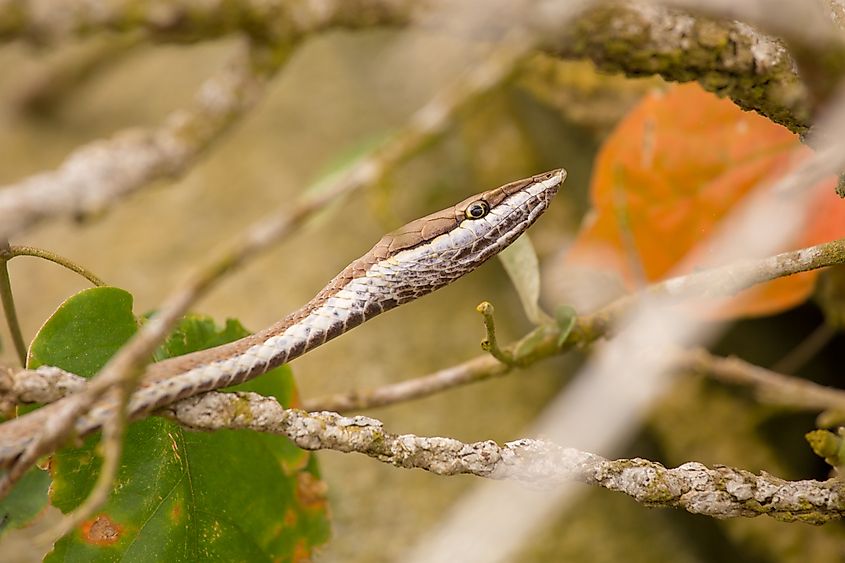
The Tropical Vine Snake, also known as the Mexican Vine Snake, is one of the more unique venomous species found in the extreme southern regions of Arizona and Mexico. This snake is very slim, with an impressive length of over 6 feet. It has a grey-to-brown topside color, making it look like a thin branch or rope in the wild. In Arizona, its range is limited to specific areas such as the Pajarito and Patagonia Mountains, and parts of Santa Cruz County. The Tropical Vine Snake primarily inhabits mesquite-invaded semi-desert grasslands, oak savanna, and riparian woodlands at elevations between 3,800 and 5,400 feet. It has a diet consisting of frogs, lizards, and small rodents. While their venom is mild and not dangerous to humans, bites can lead to localized discomfort and irritation
Venomous Snakes In Louisiana
Louisiana, with its lush wilderness, is also home to over 40 species of snakes, such as the garter snake, banded water snake, and pygmy rattlesnake. That said, as both states have diverse geography, Arizona has deserts, and Louisiana has forests, the species differ quite a bit. For example, desert species like the Mojave rattlesnake and western diamondback rattlesnake do not live in Louisiana. Instead, the state houses seven venomous snakes, including close relatives of the Mojave rattlesnake like the pygmy rattlesnake and eastern copperhead.
Eastern Copperhead (Agkistrodon contortix)
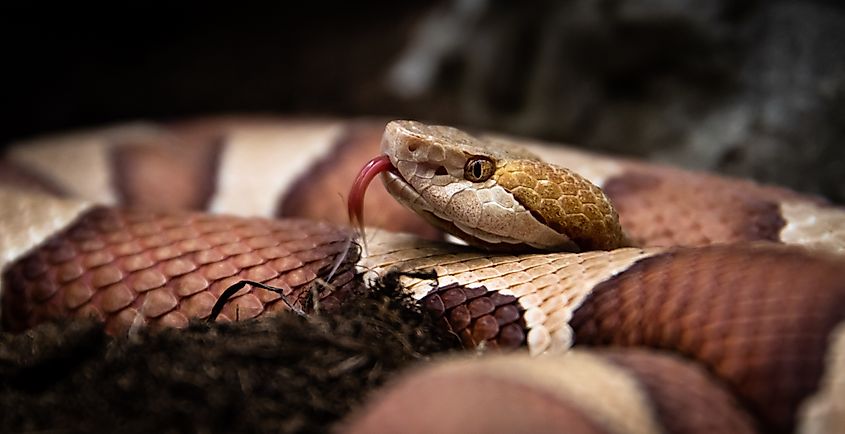
The eastern copperhead is one of America’s most venomous snakes, found in various parts of eastern North America. This pit viper is easily identified by its distinct brown hourglass marking on its lighter brown scales. In terms of size, the eastern copperhead can reach a length of up to 3 feet 3 inches, although average males tend to be between 20 and 37 inches. While they are not aggressive, eastern copperhead venom is highly toxic and can cause symptoms such as pain, swelling, and damage to bone tissue. To this end, it is essential to seek immediate medical care. In the wild, these snakes prey on a variety of animals, from millipedes and spiders to small turtles and rabbits.
Pygmy Rattlesnake (Sistrurus miliarius)
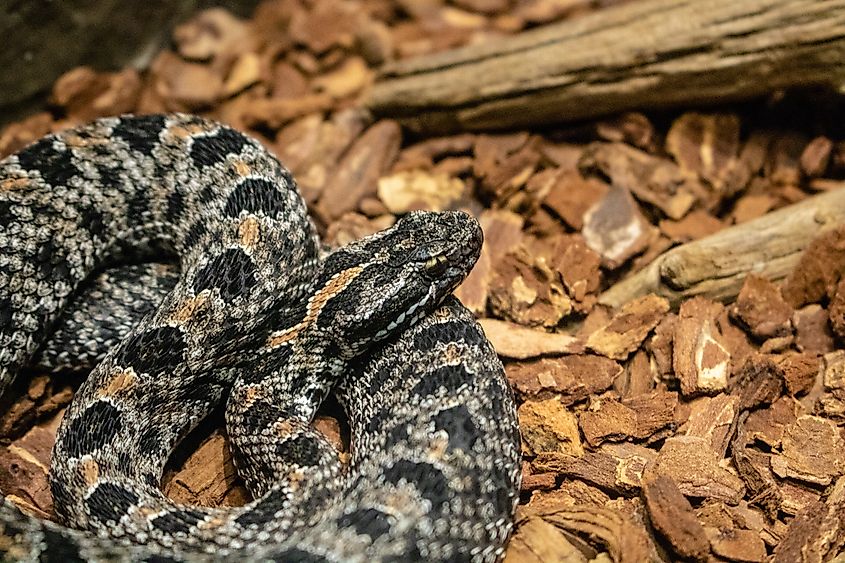
The pygmy rattlesnake is a pit viper endemic to the Southeastern United States. It features a short and thick body with a white belly and large dark circular spots along its back. Moreover, the snake also has a unique red-orange stripe that runs down the middle of its back. Thanks to this, pygmy rattlesnakes are easy to spot in the wild. This is also a good thing, as a bite from this snake can cause an array of issues due to its hemorrhagic and cytotoxic nature. Notable symptoms include blood loss, internal bleeding, pain, and nausea. It is so powerful at preventing clotting that the venom has been used in medicines to prevent clotting during heart attacks. Most pygmy rattlesnakes are found near floodplains, mixed forests, and marshes, so keep an eye on the ground when in these wetter environments.
Texas Coral Snake (Micrurus tener)
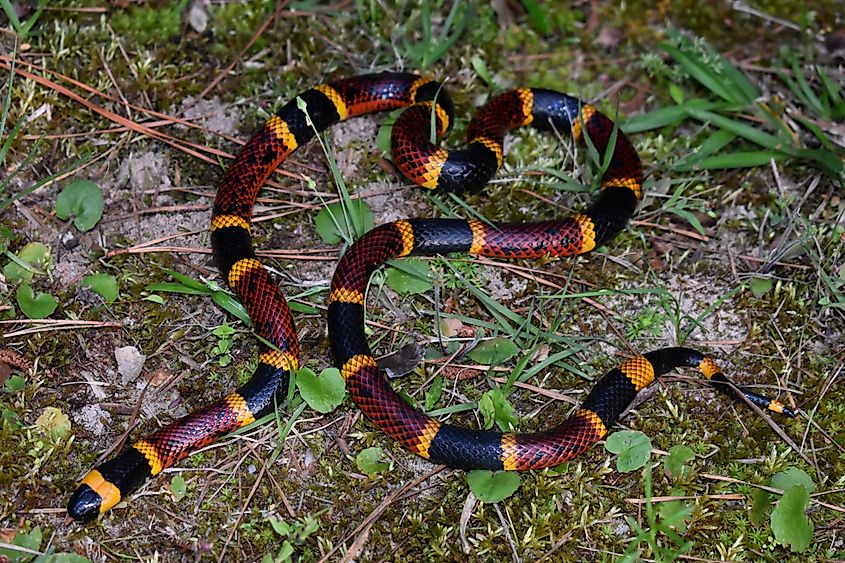
Known for their vibrant coloration, the Texas coral snake is another of Louisiana’s venomous snake species. This snake boasts the iconic black, yellow, and red coral snake bands and can reach lengths of up to 48 inches, although most are around 24 inches. It has quite an erratic behavior and will sometimes be calm when touched or randomly thrash about and swing its body. Regarding venom, the Texas coral snake is one of the more dangerous snakes in the state, with a neurotoxic and myotoxic venom that has a fatality rate of around 10%. Thankfully, bites are rare, and the snake’s vibrant characteristics make it easy to spot from afar.
First Aid
While most people avoid venomous snakes, many can hide along paths, under rocks, and around foliage, leading to unwanted bites. In case you are bitten, there are some steps to follow that can reduce harm. First, get away from the area as soon as possible to avoid further bites, loosen any tight clothing, or remove accessories near the bite site. Afterward, contact health authorities or try to reach the nearest medical center while applying pressure at the bite site. Although it is famed in pop culture, do not try to suck the venom out with your mouth, as this will usually not lead to much benefit and can further irritate the wound.
Arizona’s Greater Variety of Venomous Snakes
When comparing the two states, Arizona clearly has more venomous snake species than Louisiana. Arizona, with its diverse deserts, mountains, and forests, is home to 21 venomous snakes, including a wide range of rattlesnakes like the Mojave and the Western Diamondback, along with the Arizona Coral Snake. Louisiana, while rich in wildlife, only hosts seven venomous species, including the Eastern Copperhead, Pygmy Rattlesnake, and Texas Coral Snake. Therefore, Arizona surpasses Louisiana in both the variety and number of venomous snakes due to its unique landscapes and habitats.











